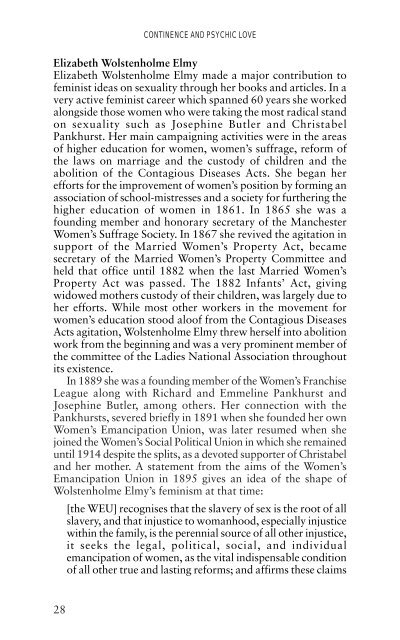The Spinster and Her Enemies - Feminish
The Spinster and Her Enemies - Feminish
The Spinster and Her Enemies - Feminish
You also want an ePaper? Increase the reach of your titles
YUMPU automatically turns print PDFs into web optimized ePapers that Google loves.
CONTINENCE AND PSYCHIC LOVE<br />
Elizabeth Wolstenholme Elmy<br />
Elizabeth Wolstenholme Elmy made a major contribution to<br />
feminist ideas on sexuality through her books <strong>and</strong> articles. In a<br />
very active feminist career which spanned 60 years she worked<br />
alongside those women who were taking the most radical st<strong>and</strong><br />
on sexuality such as Josephine Butler <strong>and</strong> Christabel<br />
Pankhurst. <strong>Her</strong> main campaigning activities were in the areas<br />
of higher education for women, women’s suffrage, reform of<br />
the laws on marriage <strong>and</strong> the custody of children <strong>and</strong> the<br />
abolition of the Contagious Diseases Acts. She began her<br />
efforts for the improvement of women’s position by forming an<br />
association of school-mistresses <strong>and</strong> a society for furthering the<br />
higher education of women in 1861. In 1865 she was a<br />
founding member <strong>and</strong> honorary secretary of the Manchester<br />
Women’s Suffrage Society. In 1867 she revived the agitation in<br />
support of the Married Women’s Property Act, became<br />
secretary of the Married Women’s Property Committee <strong>and</strong><br />
held that office until 1882 when the last Married Women’s<br />
Property Act was passed. <strong>The</strong> 1882 Infants’ Act, giving<br />
widowed mothers custody of their children, was largely due to<br />
her efforts. While most other workers in the movement for<br />
women’s education stood aloof from the Contagious Diseases<br />
Acts agitation, Wolstenholme Elmy threw herself into abolition<br />
work from the beginning <strong>and</strong> was a very prominent member of<br />
the committee of the Ladies National Association throughout<br />
its existence.<br />
In 1889 she was a founding member of the Women’s Franchise<br />
League along with Richard <strong>and</strong> Emmeline Pankhurst <strong>and</strong><br />
Josephine Butler, among others. <strong>Her</strong> connection with the<br />
Pankhursts, severed briefly in 1891 when she founded her own<br />
Women’s Emancipation Union, was later resumed when she<br />
joined the Women’s Social Political Union in which she remained<br />
until 1914 despite the splits, as a devoted supporter of Christabel<br />
<strong>and</strong> her mother. A statement from the aims of the Women’s<br />
Emancipation Union in 1895 gives an idea of the shape of<br />
Wolstenholme Elmy’s feminism at that time:<br />
[the WEU] recognises that the slavery of sex is the root of all<br />
slavery, <strong>and</strong> that injustice to womanhood, especially injustice<br />
within the family, is the perennial source of all other injustice,<br />
it seeks the legal, political, social, <strong>and</strong> individual<br />
emancipation of women, as the vital indispensable condition<br />
of all other true <strong>and</strong> lasting reforms; <strong>and</strong> affirms these claims<br />
28

















